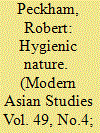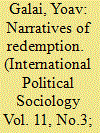|
|
|
Sort Order |
|
|
|
Items / Page
|
|
|
|
|
|
|
| Srl | Item |
| 1 |
ID:
089386


|
|
|
|
|
| Publication |
2009.
|
| Summary/Abstract |
Despite the contemporary importance of the Ridge forest to the city of Delhi as its most important 'green lung', the concept of urban forestry has been explored neither by urban historians studying Delhi nor by environmental historians. This article places the colonial efforts to plant a forest on the Delhi Ridge from 1883 to 1913 within the context of the gradual deforestation of the countryside around Delhi and the local colonial administration's preoccupation with encouraging arboriculture. This project of colonial forestry prioritized the needs of the white colonizers living in Delhi, while coming into conflict repeatedly with indigenous peasants. With the decision to transfer the capital to Delhi in 1911, the afforestation of the Delhi Ridge received a further stimulus. Town planners' visions of a building the capital city of New Delhi were meant to assert the grandeur of British rule through imposing buildings, with the permanence of the British in India being emphasised by the strategic location of the ruins of earlier empires within the city. The principles of English landscape gardening inspired the planning of New Delhi, with the afforestation of the Delhi Ridge being undertaken to provide a verdant backdrop for-the Government House and the Secretariat-the administrative centre of British government in India. Imperial notions of landscaping, which were central to the afforestation of the Delhi Ridge epitomised colonial rule and marginalized Indians.
|
|
|
|
|
|
|
|
|
|
|
|
|
|
|
|
| 2 |
ID:
140296


|
|
|
|
|
| Summary/Abstract |
This article examines the ‘greening’ of Hong Kong in the late nineteenth and early twentieth centuries, with an emphasis on the afforestation of the colony's ‘barren’ mountainsides from the 1880s. To date, histories of Hong Kong have tended to focus on the colonial state's urban interventions, particularly on the draconian measures it took to ‘sanitize’ Chinese districts. In contrast, this article connects Hong Kong's urban development with the history of green space and the cultivation of ‘nature’. While the state sought to transform the ‘barren rock’ into a visible correlate of the colony's aspiring status as an imperial hub in Asia, the promotion of hygiene and health provided a further rationale for tree-planting. The article argues that colonial Hong Kong provides insights into the ‘tropicalization of modernity’ and the constitutive processes by which colonial power was naturalized and legitimated through planning practices that extended from the urban to the natural. A study of Hong Kong's afforestation underscores the importance of the natural environment as a ‘contact zone’ between colonial and ‘native’ cultures; it also reveals the extent to which the equation of a ‘green’ landscape with economic (re)production and colonial order, functioned as a critical trope for framing race and labour.
|
|
|
|
|
|
|
|
|
|
|
|
|
|
|
|
| 3 |
ID:
110497


|
|
|
|
|
| Publication |
2011.
|
| Summary/Abstract |
This paper uses data from a 2003 rural survey to examine the determinants of household provision of environmental services under China's Sloping Land Conversion Program (SLCP), the largest payments for environmental services program in the developing world. The paper examines the determinants of plot-level survival rates of program-planted trees and grasses. It finds that household rights over retired land as well as autonomy in program decision-making (which we argue on the basis of supportive evidence are plausibly exogenous to post-retirement outcomes) have important and potentially countervailing impacts on the provision of environmental services targeted by the program. Households permitted to select what to plant obtain better program outcomes, but do not make the choices that the government would like them to, while those permitted to decide what land to retire perform worse. The analysis also finds that households more vested and experienced in agriculture and with less exposure to off-farm labor markets fare better in managing their planted trees. Significant learning-by-doing effects are also evident, suggesting that greater technical support to farmers could improve outcomes and lower program costs.
|
|
|
|
|
|
|
|
|
|
|
|
|
|
|
|
| 4 |
ID:
155146


|
|
|
|
|
| Summary/Abstract |
A political project will be considered legitimate if the narrative that frames it is. This article explores the legitimizing function of narratives as well as the ways in which the narrative form can travel across borders, contexts, and discourses. The new, afforested landscape of Israel is the result of an intensive campaign of planting almost a quarter of a billion trees. Forests often cover the remains of Palestinian villages, demolished after they were abandoned in 1948. Nevertheless, through the work of narrative, the afforested landscape is instilled with a sense of the recovery of an imagined biblical landscape associated with ancient Jewish ownership of the land. This basic narrative of “redemption” has been carried over to frame new forests that similarly overwrite land claims by indigenous inhabitants. However, the new forests are presented as celebrations of international cooperation by involving foreign actors. Nevertheless, as I shall demonstrate, the particular designations of these forests, which are international in nature, still comply with a basic narrative of “redemption.”
|
|
|
|
|
|
|
|
|
|
|
|
|
|
|
|
|
|
|
|
|